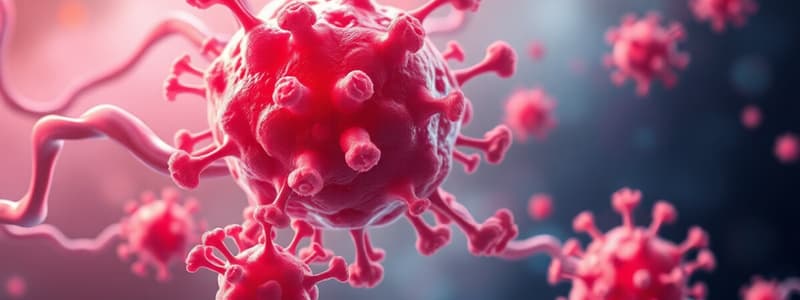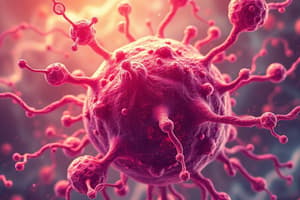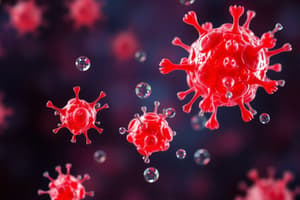Podcast
Questions and Answers
Which receptor type primarily mediates the effects of histamine on itch and pain in the skin?
Which receptor type primarily mediates the effects of histamine on itch and pain in the skin?
- H4 receptor
- H1 receptor (correct)
- H2 receptor
- H3 receptor
What is the primary pharmacological effect of H1 receptor antagonists on vascular smooth muscle?
What is the primary pharmacological effect of H1 receptor antagonists on vascular smooth muscle?
- Stimulation of muscle contraction
- No effect on vascular smooth muscle
- Inhibition of vasodilation and increased permeability (correct)
- Increased vasodilation
In what condition can the administration of high doses of histamine result in a significant drop in blood pressure?
In what condition can the administration of high doses of histamine result in a significant drop in blood pressure?
- Cetirizine overdose
- Chronic urticaria
- Hay fever
- Anaphylaxis (correct)
Which of the following antihistamine types is known to cross the blood-brain barrier and may cause adverse effects?
Which of the following antihistamine types is known to cross the blood-brain barrier and may cause adverse effects?
Which allergic condition is primarily treated with H1 receptor antagonists?
Which allergic condition is primarily treated with H1 receptor antagonists?
What is an example of a second-generation antihistamine that does not cross the blood-brain barrier?
What is an example of a second-generation antihistamine that does not cross the blood-brain barrier?
What is the term for the localized skin response characterized by a red spot, flare, and wheal formation due to histamine injection?
What is the term for the localized skin response characterized by a red spot, flare, and wheal formation due to histamine injection?
Which histamine receptor is mainly involved in mediating wakefulness and alertness in the central nervous system?
Which histamine receptor is mainly involved in mediating wakefulness and alertness in the central nervous system?
Which histamine receptor is mainly associated with increasing intracellular calcium levels and producing nitric oxide?
Which histamine receptor is mainly associated with increasing intracellular calcium levels and producing nitric oxide?
Which receptor type is primarily involved in regulating gastric acid secretion?
Which receptor type is primarily involved in regulating gastric acid secretion?
What is the primary signaling mechanism of the H3 receptor?
What is the primary signaling mechanism of the H3 receptor?
In the context of allergic reactions, what is a primary action of histamine?
In the context of allergic reactions, what is a primary action of histamine?
Which type of antihistamine primarily functions as a competitive antagonist at H1 receptors?
Which type of antihistamine primarily functions as a competitive antagonist at H1 receptors?
Which statement accurately describes the primary site for the storage of histamine in the human body?
Which statement accurately describes the primary site for the storage of histamine in the human body?
Which histamine receptor is primarily involved in mediating allergic reactions and anaphylaxis?
Which histamine receptor is primarily involved in mediating allergic reactions and anaphylaxis?
What is the primary mechanism by which histamine is released from mast cells?
What is the primary mechanism by which histamine is released from mast cells?
Which of the following statements about antihistamines is correct?
Which of the following statements about antihistamines is correct?
Which type of histamine receptor is mainly associated with modulating gastric acid secretion?
Which type of histamine receptor is mainly associated with modulating gastric acid secretion?
What role does histamine play in inflammation?
What role does histamine play in inflammation?
Which of the following autacoids is most structurally similar to histamine?
Which of the following autacoids is most structurally similar to histamine?
Histamine synthesis involves which amino acid as its precursor?
Histamine synthesis involves which amino acid as its precursor?
Which receptor subtype is primarily found on neurons and is involved in neurotransmission?
Which receptor subtype is primarily found on neurons and is involved in neurotransmission?
How does histamine affect smooth muscle in the airways during an allergic reaction?
How does histamine affect smooth muscle in the airways during an allergic reaction?
Which amino acid is directly involved in the synthesis of histamine?
Which amino acid is directly involved in the synthesis of histamine?
What is one of the primary uses of first-generation H1 antagonists?
What is one of the primary uses of first-generation H1 antagonists?
What enzyme is responsible for converting histidine into histamine?
What enzyme is responsible for converting histidine into histamine?
Which of the following is a characteristic of H2 receptor antagonists?
Which of the following is a characteristic of H2 receptor antagonists?
Which action is commonly associated with the activation of 5-HT1B and 5-HT1D receptors?
Which action is commonly associated with the activation of 5-HT1B and 5-HT1D receptors?
Which cells are primarily involved in the storage of histamine?
Which cells are primarily involved in the storage of histamine?
Which mechanism involves the explosive release of histamine from mast cells upon re-exposure to an antigen?
Which mechanism involves the explosive release of histamine from mast cells upon re-exposure to an antigen?
Which neurotransmitter's synthesis begins with the dietary amino acid L-tryptophan?
Which neurotransmitter's synthesis begins with the dietary amino acid L-tryptophan?
What role do H2 receptors play in the regulation of histamine release?
What role do H2 receptors play in the regulation of histamine release?
What is the primary mechanism of action of first-generation antihistamines?
What is the primary mechanism of action of first-generation antihistamines?
Which of the following side effects is commonly associated with first-generation H1 antagonists due to their antimuscarinic effects?
Which of the following side effects is commonly associated with first-generation H1 antagonists due to their antimuscarinic effects?
Which of the following substances can chemically induce the release of histamine without energy expenditure?
Which of the following substances can chemically induce the release of histamine without energy expenditure?
What types of receptors are H1, H2, H3, and H4 classified as?
What types of receptors are H1, H2, H3, and H4 classified as?
What type of receptor is the 5-HT3 receptor classified as?
What type of receptor is the 5-HT3 receptor classified as?
Which symptom is most likely to occur due to the effects of 5-HT on the vomit center in the brain?
Which symptom is most likely to occur due to the effects of 5-HT on the vomit center in the brain?
Which of the following effects is NOT a direct result of activating H1 receptors?
Which of the following effects is NOT a direct result of activating H1 receptors?
Histamine released in response to allergens is primarily associated with which type of immune response?
Histamine released in response to allergens is primarily associated with which type of immune response?
What is the predominant effect of antihistamines on allergic reactions?
What is the predominant effect of antihistamines on allergic reactions?
Antihistamines primarily function by blocking which type of receptors?
Antihistamines primarily function by blocking which type of receptors?
How is serotonin primarily degraded in the body?
How is serotonin primarily degraded in the body?
Flashcards are hidden until you start studying
Study Notes
Histamine
- Histamine is a chemical mediator released from cells in response to various stimuli.
- It elicits both physiological and pathological effects in the body.
- Its primary role is in immune responses, but it also has roles in neurotransmission, gastrointestinal function and blood pressure regulation.
Histamine Distribution
- Histamine is primarily found in mast cells, located in tissues throughout the body.
- Mast cells are responsible for storing and releasing histamine in response to allergens and other stimuli.
- Histamine is also found in non-mast cell locations, including neurons of the central nervous system, the gastric mucosa, and blood basophils.
Histamine Receptors
- There are four known histamine receptors (H1, H2, H3, and H4), all of which are G protein-coupled receptors (GPCRs).
- H1 receptors are primarily located in smooth muscle (vascular and bronchial), endothelial cells, the CNS, and other cell types (e.g., epithelial and endothelial cells, neutrophils, eosinophils, monocytes, and dendritic cells).
- H2 receptors are found in the gastric mucosa, parietal cells, cardiac muscle, smooth muscle, mast cells, and the CNS.
- H3 receptors are predominantly located in the CNS, serving as presynaptic autoreceptors that regulate histamine release.
- H4 receptors are primarily found on cells of hematopoietic origin (e.g., neutrophils, eosinophils, mast cells, and basophils) and contribute to the development of inflammatory responses.
Histamine Synthesis and Storage
- Histamine is synthesized from the amino acid histidine by the enzyme L-histidine decarboxylase.
- Mast cells and basophils synthesize and store histamine in secretory granules.
- Non-mast cells (e.g., epidermis, gastric mucosa, and neurons) synthesize histamine but don't store it, leading to rapid excretion.
Histamine Release
- Histamine release from mast cells can occur through:
- Immunological release: IgE-mediated degranulation triggered by exposure to allergens.
- Chemical and mechanical release: Certain amines, drugs (e.g., morphine and tubocurarine), or physical stimuli.
- The release of histamine triggers a cascade of events in the body, leading to the characteristic symptoms of allergies and inflammation.
Histamine's Action
- Histamine acts primarily through its receptors, leading to a variety of effects depending on the receptor subtype involved.
- H1 receptor activation leads to vasodilation, increased vascular permeability, smooth muscle contraction, and itching.
- H2 receptor activation primarily results in the stimulation of gastric acid secretion.
- H3 receptor activation inhibits histamine release in the CNS, regulating neurotransmission.
- H4 receptor activation promotes the recruitment and activation of inflammatory cells, contributing to inflammatory responses.
Histamine and Allergy
- Histamine plays a crucial role in mediating allergic reactions, including:
- Allergic rhinitis: Runny nose, sneezing, and nasal congestion.
- Atopic dermatitis: Skin inflammation, itching, and rashes.
- Urticaria: Hives or welts.
- Insect bites: Local inflammation and itching.
- Drug hypersensitivity reactions: Reactions to medications.
- Allergic reactions occur when the immune system overreacts to a normally harmless substance (allergen), leading to the release of histamine from mast cells.
Histamine and Anaphylaxis
- Anaphylaxis is a severe and potentially life-threatening allergic reaction characterized by a rapid and widespread release of histamine.
- Systemic anaphylaxis can cause:
- Bronchospasm (wheezing and difficulty breathing)
- Vasodilation (low blood pressure)
- Edema (swelling)
- Cardiovascular collapse
Antihistamines
- Antihistamines are drugs that block the effects of histamine by competing with histamine for binding to its receptors.
- H1 receptor antagonists are primarily used to treat allergic reactions, such as allergic rhinitis, urticaria, and atopic dermatitis.
- H2 receptor antagonists are used to treat gastrointestinal conditions, such as peptic ulcers and gastroesophageal reflux disease (GERD), by reducing gastric acid secretion.
- There are two generations of H1 receptor antagonists:
- First-generation: These are non-selective, meaning they also block other receptors in the body, such as muscarinic, α-adrenergic, and serotonin receptors. Examples: chlorpheniramine, diphenhydramine, pheniramine, and promethazine.
- Second-generation: These are highly selective for H1 receptors and do not cross the blood-brain barrier, minimizing CNS-related side effects. Examples: loratadine, cetirizine, desloratadine, and fexofenadine.
Summary
Histamine is a crucial mediator in various physiological processes, including immune responses, neurotransmission, and gastrointestinal function. It acts through four specific receptors, each contributing to different effects in the body. Allergic reactions are characterized by the excessive release of histamine, leading to a range of symptoms such as itching, sneezing, and inflammation. Antihistamines are effective medications that block histamine's action, reducing allergic symptoms and improving patient outcomes.
Studying That Suits You
Use AI to generate personalized quizzes and flashcards to suit your learning preferences.



